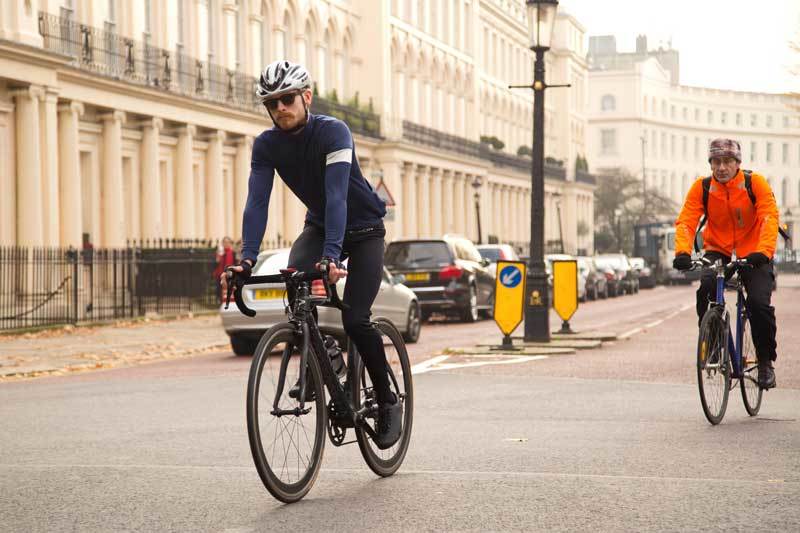8 Tips to help you transform daily bike commute into quality bike training

With a limited number of hours every day, it can be difficult to cram in hours of training on your bike to keep up your fitness.
Being able to get in a daily workout on your bike – or at least maintaining a regular training schedule – can make a huge difference if you are training for summer bike racing or a destination ride.
Finding opportunities to practice interval training on the bike can also do wonders for your general health and fitness.
Thankfully, if you’re already commuting between home and work by bike each day, you have a built-in opportunity to add a bike workout to your day.
With just a few modifications to your existing commuting routine, you can add extra miles and introduce interval training that can substitute for a standalone training plan – without adding the significant time burden of a standalone training plan.
In this article, we’ll highlight eight changes that you can make to help you transform your daily bike commute into quality bike training.
Key Tips for Your Workout

Before you worry about mixing up your commute to introduce training, there are a few basic things to consider.
First, the frequency is key to any training routine – and that includes training during your commute. If you’re not commuting by bike or adding intervals into your ride routinely, you are not likely to reap the health and strength benefits from your workouts.
That said, you’ll also want to make sure you include plenty of rest in your cycling routine. Plan for at least one day of rest between interval workouts and no more than three days of adding intervals into your commute per week.
Another thing to consider is that to see whether your workout routine is effective, you need to be able to track your progress over time. Depending on your goals, tracking could be as simple as weighing yourself, but for many cyclists more detailed information about how your speed, cadence, heart rate, and power are changing over time will be much more useful.
Consider wearing a heart rate monitor during your commute or adding a power meter to your bike, as well as using a tracking app like Strava or a GPS watch to log your miles and speed.
Pro Tip:
If you’re planning to add your interval work into your morning commute, rather than your afternoon commute, be sure to bring an extra set of clothes for when you get to work – you’ll sweat more than you would during a normal relaxed commute.
Warm Up

Warming up is a key part of any workout, but it is easy to forget or ignore when mixing your workout into your commute.
The first 10-12 minutes of your commute should be easy spinning to get your legs going, followed by 10 minutes at a moderate pace to prepare your legs for the hard work ahead.
You can also warm up by practicing pedaling with only one leg in intervals of 30 seconds per leg.
Extend Your Mileage

If you’re bike commuting to work, hopefully, the distance between your home and work isn’t more than a few miles. But real training requires spending more than 10-20 minutes total on the bike, so you’ll likely need to extend your route either on the way to work or on the way home.
The advantage of being able to extend your existing ride is that you save a huge amount of time by not having to change, prep water bottles, warm up, and add a shower after the ride as you would for a standalone workout ride.
Take further advantage of your extra miles by adding hills into your ride that your commute ordinarily avoids.
Of course, note that adding miles will also extend the time it takes you to get to work or home, so plan accordingly.
Pro Tip:
Your added mileage doesn’t need to follow the same route every time like the rest of your commute – use this as an opportunity to explore new roads. Trying new routes during the training portions of your commute rides will keep your mind fresh and help you stay motivated to ride. If possible, add mileage on less trafficked roads so that you can take your mind off of passing cars and your intervals won’t be interrupted by stop signs and traffic lights.
Practice Acceleration

If you are stopped at a red light or a stop sign, challenge your legs by powering into motion when the time comes rather than lackadaisically rolling and spinning up to speed.
Laying the hammer down in 10-20 second intervals is excellent strength training for your legs that transfers well to being able to accelerate past competitors in a race.
For best results, start on an easier gear and add gears rapidly as you accelerate to keep the tension on the pedals.
Add Resistance
One of the best ways to teach your legs to continue working hard when tired is to challenge them with high-resistance, low-cadence pedaling. Add enough gears so that your cadence – the rate at which your legs are rotating the pedals - drops to around 60 rpm, then work to keep your pace steady for intervals ranging from 30 seconds to 2 minutes depending on your ability level.
Pro Tip:
Only try this on stretches of road with few stop signs and red lights. Otherwise, you are likely to end up coming to a stop in a very high gear, which can make it extremely difficult to get moving again.
Increase Your Cadence

Essentially the opposite of adding resistance, increasing your cadence in an easy gear can teach your legs to turn over faster and keep a smooth rhythm – both of which will make you a more efficient cyclist over time and save your legs for harder intervals in the same workout.
Your target cadence for these intervals should be between 110-125 rpm, sustained for periods of 30 seconds to two minutes depending on your ability level.
If you have time, approach these intervals by starting at 90 rpm and then increasing by 5 rpm with every interval until you reach your maximum cadence.
If you find that you are bouncing on your seat, add a gear of resistance – but don’t add any more resistance than you need.
Include Tempo Intervals

“Tempo” has a different meaning depending on what your goal pace and distance is, but a good rule of thumb is that tempo pace is the fastest pace you could keep up for 30 minutes in a race scenario – fast, but not so fast that you should be dying during 5-10 minute intervals.
Adding tempo intervals can improve your overall speed and endurance and should be one of the main types of workouts that you include in your commuting rides.
Give yourself plenty of rest between intervals – up to half of the interval period – and make sure you have a long stretch of open road before beginning an interval so that you are not interrupted.
Try Fartleks

Fartleks are a perfect fit for the busy commuter who doesn’t have time to plan a traditional interval workout or to add miles into an existing commute route.
This style of interval training is unorganized in that you can spontaneously choose how far and how fast you’ll be going during the interval, and each interval can be different – it all depends on how you’re feeling and the terrain you’re riding on.
For best results, have a set intensity and duration – whether that’s a mental finish line on the road ahead or a set number of seconds – for each fartlek in mind before you start.
Try Tabata Intervals

If disorganized intervals aren’t for you, consider adding Tabata intervals into your workout on occasion. Tabata intervals require three sets of eight intervals, each 20 seconds long, with 10 seconds of rest between each interval and 10 minutes of rest between each set.
Although these intervals sound short, they should be at an all-out effort – you should be working hard to keep up your cadence by the sixth interval and screaming for air by the last interval in each set.
This interval routine is designed to push you to your limits, so mix a Tabata workout into your routine only once a week or less frequently.
Focus on Bike Handling

Bike handling is one of the most neglected aspects of cycling that can make or break during race scenarios – too many cyclists lose time when cornering or descending steep hills.
Commuting is the perfect opportunity to practice bike handling because your commuting bike is likely loaded down with stuff that makes it harder to handle than an unencumbered road bike.
Read our commuter bike buying guide here- www.rydoze.com/commuter-bikes
Seek out hills on your extended route to practice descending and sharp curves (on roads with ample line of sight for safety) to practice making sharp curves while keeping your balance centered.
Also, try incorporating specific bike handling drills into your ride to build your skills.
It can be difficult to build enough time into each day to get in a full cycling workout, but thankfully you can turn your daily commute into interval training with just a few modifications to the way you approach your ride.
These eight modifications will help you build speed, endurance, and leg strength to prepare you for a racing season or a big ride or to keep your fitness up.

